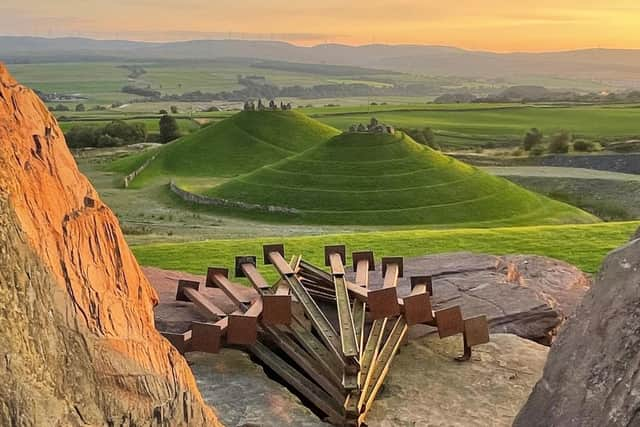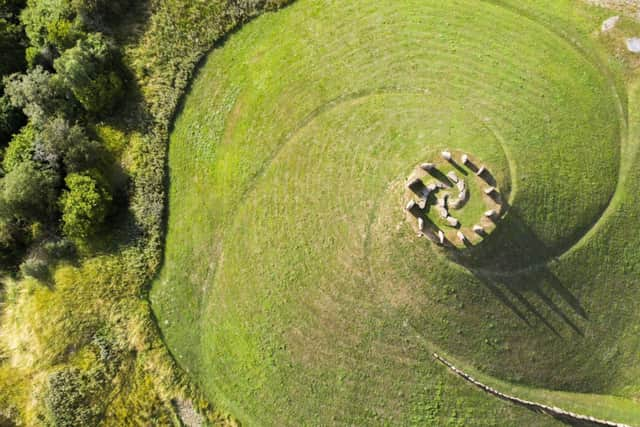Arts and science meet at Crawick Multiverse's summer solstice celebration
Summer solstice is the longest day and shortest night of the year. It also involves the moment of maximum tilt of the Earth towards the Sun. In the Northern Hemisphere, summer solstice usually falls on 21 June, or a day either side. This year, the Open University in Scotland and the spectacular art-land Crawick Multiverse, near Sanquhar in Dumfries and Galloway, are collaborating in hosting a week’s events to celebrate the artistic, scientific, and cultural significances of the solstice.
In our era of increasing climate and extinction dangers, the Crawick Multiverse solstice events – which are all open to the public – will weave together participative celebration and interactive education honouring the life-giving relationship of Earth and Sun. Everyone is invited to join in the celebrations and gain inspiration. The Crawick Multiverse is the perfect location for celebrating the solstice whilst reflecting on the lively beauty of our world. Indeed, the site not only roots us in our blue-green planet but also places us among our larger cosmic connections.
Advertisement
Hide AdIn 2005, the landscape artist Charles Jencks was invited by the Duke of Buccleuch to transform 55 acres of abandoned open-cast coal mine into a place of beauty and inspiration. Jencks – who also designed landscapes at Jupiter Artland and the Scottish Modern Gallery of Modern Art (Modern One) – saw the potential of the site to become a massive artwork, a restored ecology, a revelation of the cosmos and therefore a place of celebration and learning. Speaking at the site when it opened in 2015, Jencks said: “Crawick Multiverse is one of the greatest pleasures of my life, a cosmic landscape…It’s wonderful to see this park used in different ways, and for a designer such as me that’s the pay-off.”


Years of earth-moving, involving thousands of boulders and tonnes of earth, resulted in the creation of a vista of beauty out of a once-ravaged landscape. The Multiverse’s giant conical grass mounds represent colliding galaxies, and its long avenue of boulders from the coal mine and other features are inspired by the sun, stars, and other wonders of the cosmos. The aims and ambitions of the charitable trust, The Crawick Multiverse Trust, are completely in alignment with those of The Open University; those of making life-shaping education in the arts, sciences and humanities available, accessible and relevant to today’s society. A week of activities for the 2023 summer solstice (18-24 June) is the result of the two groups working together to encourage the growth of fascination with celestial events and the festive feel they create in us.
At the Multiverse site – and at other local venues – activities will stimulate similar awe about the cosmos as that of our ancestors who built stone circles and monuments at Stonehenge. Knowledge derived from scientific and cultural research will be brought together with ceremonies to inspire desire for further celebrations and study. The 2023 solstice week of activities builds on previous solstice events at the Crawick Multiverse. This time, there will be talks by Open University professors and lecturers of art history (Robert Wallis and Lindsay Crisp), planetary and space sciences (Monica Grady and Mahesh Anand), climate change (Stephen Peake), and of religious studies (Liudmila Nikanorova and myself). Tours of the Multiverse will include opportunities to record your own sensory impressions and reflections. Drumming led by musician Mat Clements, together with storytelling and craft-making workshops led by the environmental educator Gordon MacLellan, will build up to participation in the afternoon "tilt” ceremony.My own contributions are rooted in my long-term research interests. Having been brought up near Stonehenge and joined in the free festival there in the 1970s and ‘80s, I became interested in the rituals and storytelling that inspired and encouraged solstice ceremonies and ecological lifestyles. In particular, I have led research about “animism”: ways of engaging respectfully with the larger-than-human community of living beings. Having celebrated many solstice sunrises, recent conversations with Prof Stephen Peake, my colleague from the Open University’s science faculty, have also shown me the importance of the “moment of maximum tilt” of Earth towards the Sun.
I am, therefore, eagerly anticipating celebrating both dawn and “tilt” at the Crawick Multiverse with as many people as join us for the solstice. I will work with colleagues to facilitate an event which everyone who participates can enjoy.
These will not be religious ceremonies in any formal or tradition-specific sense, nor will they involve lectures. We will meld elements of Scottish, British, Scandinavian and diverse indigenous cultural traditions – with musical and poetic contributions – into ceremonies that honour the fact that all life on Earth flows from the generosity of Earth and Sun. Something everyone can celebrate.


In between the two ceremonies, I will join with colleagues offering short interactive public talks about matters that inspire and excite us from our research. My colleague in religious studies, Liudmila Nikanorova, will talk about her participation in the largest annual summer solstice event in the world: the Yhyakh festival in Siberia’s Sakha Republic. I will talk about ceremonies offering gratitude to the Sun, especially at solstices. In particular, I’m interested in how these involve respecting Earth and Sun as living beings with interesting relationships. Excitingly, these events will range across the Crawick Multiverse, including the massive Sun Amphitheatre, which the late Charles Jencks designed with just this kind of celebration in mind.
Find out more at www.crawickmultiverse.co.uk
Advertisement
Hide AdGraham Harvey is an Emeritus Professor of Religious Studies at The Open University. His recent research engages with Indigenous animisms – ways of trying to live respectfully within the larger-than-human community.